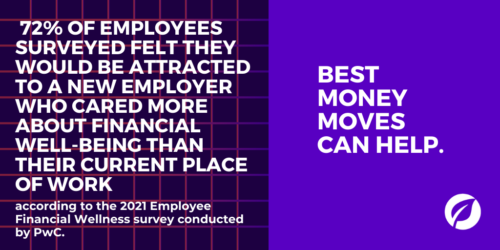
HR and Omicron: Financial Wellness Is Key to Employee Wellbeing
The Omicron variant of COVID-19 is leading to more shutdowns, changes to return-to-office plans and greater all around stress for your employees.
Research from the Society for Human Resource Management (SHRM) indicates nearly a quarter of organizations are fairly or very concerned about Omicron. The same percentage of workers expressed concern about the variant causing a reduction in their hours.
How can you help employees deal with mounting financial stress as Omicron extends the pandemic? One way is to lean on financial wellness tools and programs, like Best Money Moves.
Employee financial stress is on the rise as the pandemic drags on.
The potential for a loss of work and an overall slowing of the economic recovery from the pandemic may be putting a financial strain on your workers, especially because the number of people struggling to pay their bills was already increasing before Omicron began spreading in the U.S.
The U.S. Census’ Household Pulse Survey found that about 18% of people indicated more than one financial difficulty in September and October 2021, a month prior to the first detected case of Omicron.
Many people have been struggling to catch up on unpaid bills and mortgage payments as government interventions, like stimulus checks and enhanced unemployment insurance, went away. Some also began going back to the doctor’s and have had to deal with increased medical bills in recent months, while others faced difficulties with childcare costs as their offices returned to work.
Providing budgeting tools, credit check-ins and resources on debt management can reduce stress and, in turn, improve productivity at work.
Another area financial wellness programs can help with is emergency savings preparedness. In a 2021 survey from SSRS Omnibus, 25% of respondents indicated having no emergency savings at all, an increase from 21% the year prior. An additional 26% said they have some emergency savings, but not enough to cover their expenses for three months. Resources that show employees how to create robust savings can make it easier to survive crises — like the new variant — with less financial strain
Employee financial wellness is more important now than ever before.
Offering financial wellness benefits to employees has also become more common during the pandemic. Another recent SHRM survey found that 26% of HR professionals said their organization added benefits or expanded existing benefits to help employees manage their financial stress since the start of the COVID-19 pandemic. Organizations that already offered the benefits said they had been used more since the start of the COVID-19 pandemic, particularly financial planning and coaching.
Financial wellness programs are desired by most employees — 87% want help when it comes to personal finance, PwC found — and they are proven to work. Less stress improves overall health, lowers healthcare costs and reduces the risk of employee burnout and resignation.
Plus, they can improve the productivity of your workforce: 68% of workers in a Prudential survey said their financial wellness benefits allowed them to be more focused at work. Further, 8 in 10 said they were more likely to stay with an employer that demonstrated a commitment to helping them strengthen their financial resiliency.

Best Money Moves can help.
Best Money Moves uses artificial intelligence to power a mobile-first platform that measures employee financial stress, then dials it down with a unique content-mapping system that helps solve your employees’ pain points. The triggers and alerts system, as well as budgeting tools, personal finance resources and more, help guide employees to make smarter financial decisions and reduce their overall stress.
To learn more about Best Money Moves Financial Wellness Platform, let’s schedule a call. Contact us and we’ll reach out to you soon.







